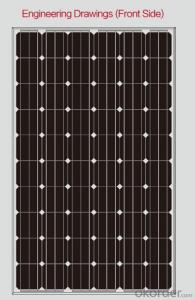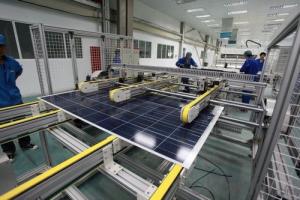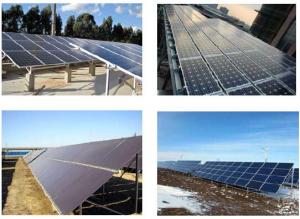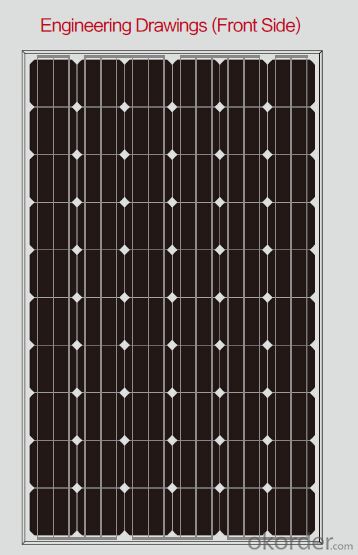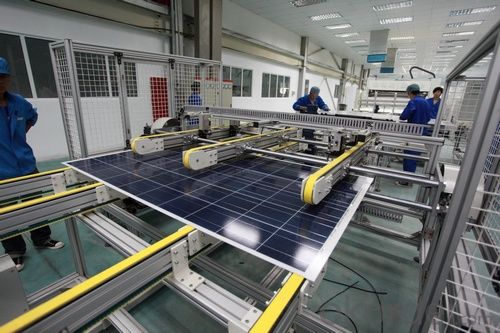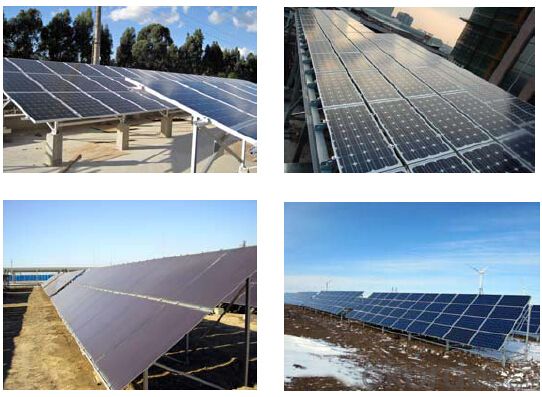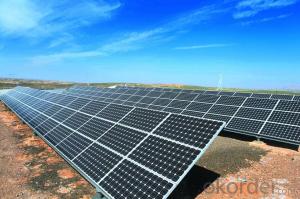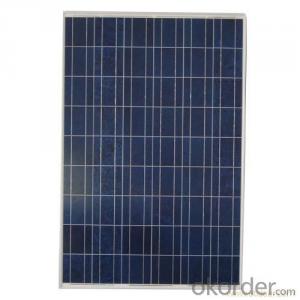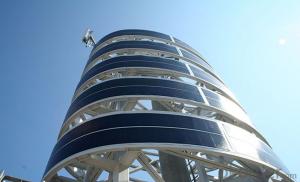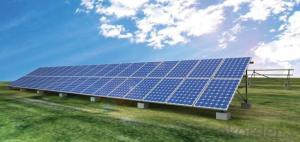Tecstar Solar Cells - High Efficiency and High Power Solar Modules
- Loading Port:
- Shanghai
- Payment Terms:
- TT OR LC
- Min Order Qty:
- 728 pc
- Supply Capability:
- 2000000 pc/month
OKorder Service Pledge
OKorder Financial Service
You Might Also Like
Specification
Advantage:
1.Widely using of the most popular and mature type of modulesfor on-grid system.
2.Specifications subject to technology and test conditions,GSUN Solar reserves the right of final interpretation.
3.Leading manufacturing technology in PV industry, strictly controlling the quality of raw materials and the process of producing.
4.100% EL inspection, ensures modules are defects free.
5.Cells binned by current to improve module performance.
6.Anti reflective glass. Not only to increase the light absorption, but also to make the module has the function of self-cleaning in water environment, effectively reducing the power loss caused by dust.
7.Outstanding performance in low-light irradiance environments.
8.Excellent mechanical load resistance: Certified to withstand high wind loads(2400pa) and snow loads(5400pa).
9.High salt and ammonia resistance.
10.Positive power tolerance:0-+5w.
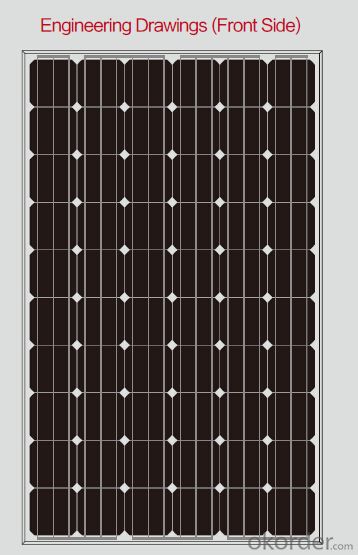
Specification:
Temperature Coefficient
NOCT | 45℃±2℃ |
Temperature Coefficients of Isc (%/℃) | 0.0492 |
Temperature Coefficients of Voc (%/℃) | –0.3374 |
Temperature Coefficients of Pmp (%/℃) | –0.4677 |
Performance Parameters
31.9 | |
Max Power Current Imp(A) | 7.85 |
Open Circuit Voltage Voc(V) | 37.7 |
Short Circuit Current Isc(A) | 8.85 |
Max Power Pm(W) | 250 |
Mechanical Data
Dimension | 1655 x 992 x 40 mm |
Weight | 22.5kg |
No. of Cells and Connections | 60 (6 x 10) |
Tolerance | 0~+5W |
Cell | Monocrystalline Cell 156 x 156 mm |
Packing | 624 Pcs/40ft(H) Container |
Warranty
5 years product warranty
10-years 90% of Min. rated output power,and 25-years 80% of Min. rated output power warranty
Comprehensive Certificates:
CE Certificate
ISO 9001:2008:Quality management systems
IEC61215、IEC61730
TUV and UL
IDCOL for Bangladesh
Feature:
- High efficiency, multicrystalline silicon solar cells with high transmission and textured glass deliver a module effi ciency of up to 16.0%,minimizing installation costs and maximizing the kWh output of your
system per unit area.
- Tight positive power tolerance of 0W to +5W ensures you receive modules at or above nameplate power and contributes to minimizing module mismatch losses leading to improved system yield.
- Top ranking in the “TÜV Rheinland Energy Yield Test”
FAQ:What's your products warranty?
No less than 90% within 10yrs and no less than 80% within 25yrs.
FAQ:What's the power range can you supply?
We can supply from 5W to 315W solar panels.
FAQ: Can you design the solar system?
Yes, We can supply the battery and controller/inverter for your system with the solar panels together.
FAQ:How much Power can I expect to get from my Solar PV’s?
Typically an installed 1kWpk array will produce 800kWh/year. 2kWpk will produce 1600kWh/year and so on.
Why are PVs rated in kWpk rather then kilowatts?
kWpk means the power expected to be generated under the comparatively ideal conditions known as STC. In other words, a 100Wp panel will produce a maximum of 100W in peak (STC) conditions - this is equivalent to a bright sunny midsummer day in the UK.
How can I connect my Solar PV system to the grid?
You will need to use a grid-tie inverter. If you wish to get paid for the electricity you produce, you will need to ensure a G83-certified inverter is used and that it is installed by a Microgeneration Certification Scheme member whose membership number will need to be provided to your electricity supplier.
How much will I get paid for the electricity I feed into the grid?
If you install a qualifying small system (1-4kWpk) in the UK before October 2012 you will get paid 16 pence for every kWh you generate regardless of whether you use it yourself or export it to other users. This is a generation tariff or feed in tariff. It will go up each year in line with inflation. If you also use the electricity you have generated this means you do not have to buy it from the electricity company and so you will save around 11-15p per kWh at todays prices (Prices subject to change of course). Energy you generate but don't use yourself, i.e. you export it to the electricity company, will attract another payment to you of 4.5p per kWh. This payment is also index linked to the RPI so it will increase in line with inflation.
Is it true that I can get my electricity meter can spin backwards?
Not usually, nor is it legal to do this. The very old meters may cause this to happen however the company installing your PV will advise you if you need to ask for a meter replacement from the company supplying your electricity. This is usually free of charge.
- Q: How do solar cells perform in regions with high levels of air pollution?
- Solar cells tend to perform less efficiently in regions with high levels of air pollution. The particles and pollutants in the air can block sunlight from reaching the solar cells, reducing their ability to generate electricity. Additionally, air pollution can accumulate on the surface of the solar panels, further reducing their efficiency. Regular cleaning and maintenance of the solar panels can help mitigate the impact of air pollution on their performance.
- Q: What is the role of grounding systems in solar cell systems?
- The role of grounding systems in solar cell systems is to provide a safe path for electrical currents to flow, ensuring the protection of both the solar panels and the users. Grounding systems help to dissipate any excess electrical energy, preventing damage to the system and reducing the risk of electrical shocks or fires. Additionally, grounding systems aid in the proper functioning of protective devices such as fuses and circuit breakers, allowing for quick detection and isolation of electrical faults. Overall, grounding systems play a crucial role in maintaining the safety and reliability of solar cell systems.
- Q: How do solar cells perform in high altitude regions?
- Solar cells perform better in high altitude regions due to several factors. Firstly, high altitude regions typically have less air pollution and less cloud cover, meaning there is more sunlight available for solar cells to convert into electricity. Additionally, the thinner air at high altitudes allows for more efficient solar cell performance, as there is less atmospheric interference. Lastly, the lower temperatures at higher altitudes can also enhance the efficiency of solar cells, as they work more effectively in cooler environments. Overall, solar cells tend to perform exceptionally well in high altitude regions.
- Q: What is the cost of solar cells?
- The cost of solar cells can vary depending on factors such as the type of technology, efficiency, and quality. Generally, the cost ranges from $0.30 to $0.80 per watt.
- Q: What is the impact of shading on solar cell performance?
- Shading has a significant negative impact on solar cell performance. When a solar cell is partially shaded, it reduces the amount of sunlight reaching the shaded area, leading to a decrease in power generation. This is because shading disrupts the flow of electrical current within the solar cell, resulting in reduced efficiency and overall output. Even a small amount of shading, such as from trees, buildings, or debris, can have a noticeable impact on the performance of the solar cell. Therefore, it is important to carefully consider the placement and positioning of solar panels to avoid shading and maximize their efficiency.
- Q: What is the impact of bird nesting on solar cell performance?
- Bird nesting can have a negative impact on solar cell performance as it can lead to shading of the panels, reducing their overall efficiency. Additionally, bird droppings can accumulate on the panels, obstructing sunlight and potentially causing damage to the cells over time. Regular maintenance and prevention measures are necessary to mitigate these effects and ensure optimal solar energy generation.
- Q: Can solar cells be used to power medical devices?
- Yes, solar cells can be used to power medical devices. Solar cells, also known as photovoltaic cells, convert sunlight into electricity. This renewable energy source can be harnessed to power various medical devices such as portable glucose monitors, prosthetics, hearing aids, and even small medical implants. Using solar cells to power medical devices offers a sustainable and convenient solution, especially in remote areas or during emergencies where access to electricity may be limited.
- Q: How do solar cells impact the local economy?
- Solar cells have a positive impact on the local economy by creating new job opportunities in the solar industry, attracting investments, and reducing energy costs for businesses and households. Additionally, the installation and maintenance of solar panels contribute to local economic growth and stimulate the development of a sustainable and resilient energy infrastructure.
- Q: Can solar cells be used in hot climates?
- Yes, solar cells can definitely be used in hot climates. In fact, solar panels tend to function more efficiently in hot weather as higher temperatures increase the conductivity of the cells, enhancing their overall performance. However, it is important to note that excessive heat may also decrease the lifespan of solar panels over time. Therefore, proper design considerations and cooling mechanisms are often employed to ensure optimal performance and longevity in hot climate installations.
- Q: Can solar cells be used in concert venues?
- Yes, solar cells can be used in concert venues. They can be installed on the rooftops or surrounding areas of the venue to convert sunlight into electricity. This renewable energy source can help power the venue's lighting, sound systems, and other electrical equipment, reducing dependence on traditional energy sources and lowering carbon emissions. Additionally, solar cells can be integrated into portable or temporary structures for outdoor concerts, providing clean energy during events.
Send your message to us
Tecstar Solar Cells - High Efficiency and High Power Solar Modules
- Loading Port:
- Shanghai
- Payment Terms:
- TT OR LC
- Min Order Qty:
- 728 pc
- Supply Capability:
- 2000000 pc/month
OKorder Service Pledge
OKorder Financial Service
Similar products
Hot products
Hot Searches
Related keywords
